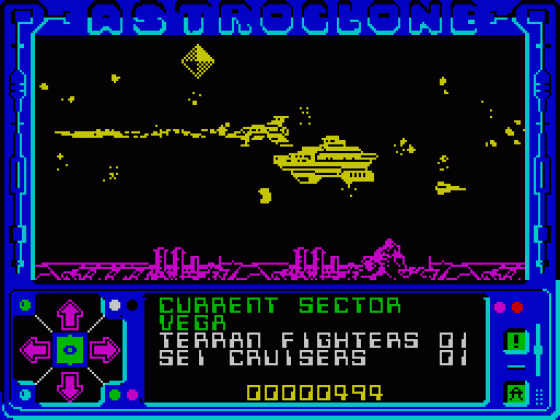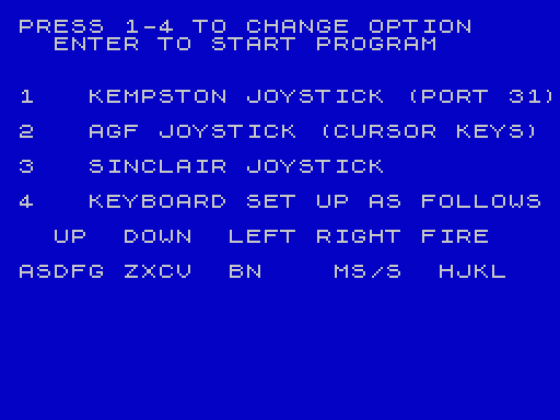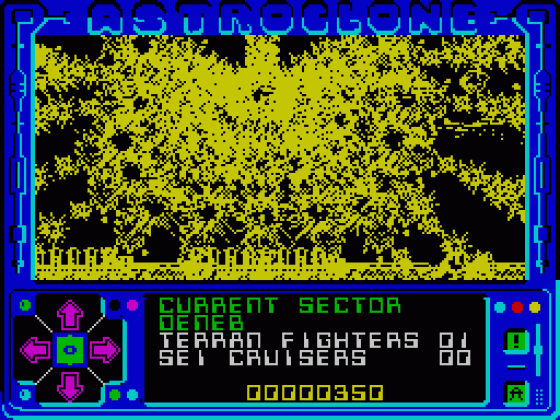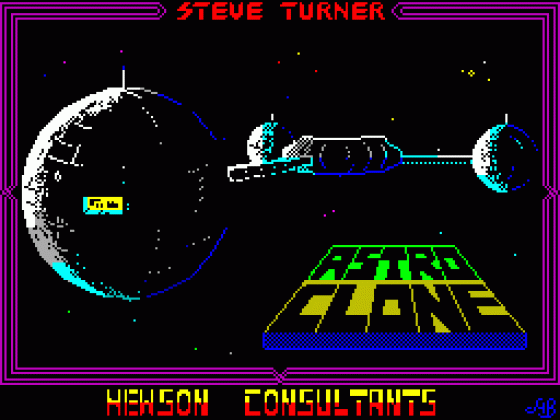

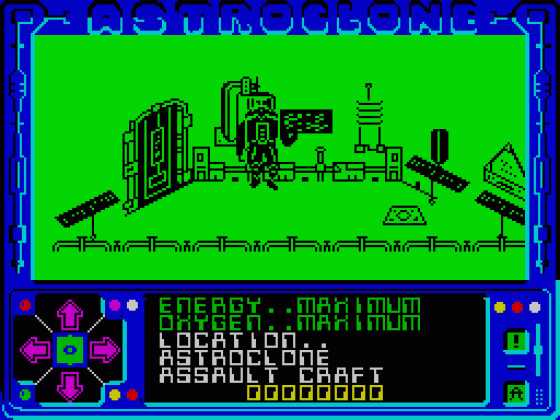


| Genre: | Arcade Game: Adventure |
| Publisher: | Hewson Consultants |
| Cover Art Language: | Multiple languages |
| Machine Compatibility: | Spectrum 48K, Spectrum 128K |
| Release: | Professionally released on Cassette |
| Available For: | Spectrum 48K |
| Compatible Emulators: | ZXSpin (PC (Windows)) Nutria (PC (MS-DOS)) |
| Original Release Date: | 12th November 1985 |
| Original Release Price: | £7.95 |
| Market Valuation: | £2.50 (How Is This Calculated?) |
| Item Weight: | 64g |
| Box Type: | Cassette Single Plastic Clear |
| Author(s): | Steve Turner & Andrew Braybrook |
Variant Items
There is 1 other item featuring this same game (that we know about!). Click any of them for their details.
Active Auctions
Closed Auctions
Buy It
Unfortunately no-one is currently selling this item.
Auction Price Watch
Worried you're being ripped off? Closing prices on eBay can help you decide what a reasonable price is for a particular item.

Computer & Video Games
1st November 1985
Astro-Clone is great fun, great value and a great challenge. The graphics are terrific - especially the explosions! Read Review

Computer Gamer
1st November 1985
The mixture of strategy, arcade and adventure elements adds greatly to the depth and appeal of the game which will take most people months to solve. Read Review

Crash
1st November 1985
A very good combination of three totally different game types. Read Review

Sinclair User
18th September 1985
The 3D graphics are handled well and the icon-driven control panel reacts in a similar way to the spells of Dragontorc. Read Review

Your Spectrum
1st September 1985
Hewson has made an excellent attempt at mixing two completely different styles of game in Astroclone but I can't help wondering whether this will appeal to the buying public. Read Review

ZX Computing
1st December 1985
Like Avalon and Dragontorc, the problem solving can slow the game down quite a lot in places, and despite the combat sequences the game may not appeal to the shoot-'em-up brigades. Read Review
Full Instructions
Control Panel | Phases Of The Game | Getting Started
Strategic Phase | Moving A Ship | Reinforcements
Ending The Phase | Space Combat Phase | Ground Combat Phase
Selection Mode | Movement Mode | Arm Mode | Laser Mode
Doors And Objects | Clones | Overall Strategy
Other Instructions | Loading
Briefing: The Seiddab Space Wars
The year was 2005 AD, the tenth year of the great asteroid rush. Rare metals had been discovered in large quantities amongst the Trojan asteroids herded around the sun by Jupiter. The initial missions had returned laden with precious cargo. Soon every ship that could escape Earth's gravity was heading for the Trojan asteroids. Obsolete craft were pressed into service including several ageing NASA space shuttles fitted with uprated side boosters.
The exodus from the three huge satellite cities was even bigger. With no need to escape the imprisoning force of Earth's gravity, anything from a Luna freighter to a customized escape pod was used to make the dangerous trek across the solar system. The tiny ships set out in great fleets, some of them strung behind freighters like a string of pearls. Unscrupulous captains were prepared to tow anything as long as they were paid. Many pioneers perished on the long voyage.
Soon a whole space industry flowered. The first regular commercial flights flew all who could afford it to the high frontier. Shuttle craft were built in thousands. Rugged and simple and with no need to operate in conditions of atmosphere or gravity they were extremely cheap. Artenis, the first outer system station was built and was soon bursting to capacity with prospectors.
Life at man's remote frontier was tough. Only a few successful prospectors returned with a fortune. But such are men's dreams that the tide could not be stopped.
Callaghan was one of the first to return with gold. With the gold fever in his blood, he spent every dollar on the latest Y-class mining vessel. Equipped with its own mining lasers and grabs, it was the envy of the average prospector. Soon Callaghan was amongst the asteroids again. After long months searching, he was returning to Artenis when his magnetometer registered a strong magnetic field.
"That rock must be solid iron", he gasped as he watched the digital read-out reach maximum.
Instinctively he checked the density. The gauge suggested an abundance of heavy metals. He whooped as he wheeled his craft to its new course.
The planetoid soon loomed large before him. It seemed regular in shape.
"Almost built", he thought, as a hundred lights flicked on illuminating strange structures. Slowly a large metal door slid open. A craft crept forward, revealing its forbidding alien shape metre by metre.
Something flashed. Callaghan recognised the colour. An Argon laser. Instinctively he threw the ship upwards in a violent manoeuvre as the deadly beam landed. His craft shook violently as one of the cargo pods discharged its pressurised contents. His trembling fingers flew to the cover protecting the laser arm switch. He tore it off and pushed the button. The craft filled with the electrical whine of the lasers charging. Already a second shot streaked towards him but his change in direction caused it to snake underneath the craft, blistering the paintwork.
Switching the engines on full vectored thrust he leap-frogged backwards over the alien craft until it was dead in his sights. He thumbed the fire button, once, twice. Suddenly his craft was thrown backward as the alien ship exploded. The Seiddab Space Wars had begun.
Flying his ship on full thrust he headed for Artenis.
He yelled his garbled story into the communicator. The flight operators smiled as they picked up his frantic voice.
"Callaghan's been at the whisky again", one remarked, but his words fell to a gaping silence as, one by one, small blips appeared in formation on his radar scope.
Making the jump across 25 light years, the automated defences of a dead civilisation responded to the first contact with life for a millennia. Eight deep space cruisers piloted by alien machines prepared for war. All systems activated, battledroids whirred to life at their stations. Generators screamed as the battle lasers charged up with deadly efficiency. A few minutes later, Artenis ceased to exist. The debris spun in every direction as Callaghan desperately turned his craft to a computer course for Earth.
The eight huge cruisers were in no hurry. With mechanical accuracy they monitored the immense stream of radio signals coming from the inner system. Battle computers requested support. Fleet after fleet of the Seiddab made ready and crossed the Stargate.
The Terran governments rejected the first reports that came flooding in as radio messages reached Earth but soon their radio telescopes confirmed the worst. Earth was facing its greatest ever threat and had only months to prepare before the alien fleet would reach the stricken planet.
Many attempts were made to communicate with the fleet as it stormed through the void, every day closing on the Earth. There was no response. An emergency resolution was passed at the United Nations creating the Terran Space Force. Immediately the whole capacity of the orbiting factories was turned to converting existing ships and to building a fleet of small hunter killer fighters based on the sleek vessels of the U.N. Space Police. The plan was simple. Get everything and anything that could carry a laser between Earth and the aliens while the new hunter killers were being completed. The aliens decimated the rag taggle in a desperate series of hit and run battles. Soon all that stood between Earth and destruction was the newly-built fleet. With their speed and maneuverability the small ships wrought havoc with the unwieldy battle cruisers of the Seiddab but they were not good enough.
The Seiddab suffered severe losses but they pressed forward. The Seiddab Attack on Earth cities began.
Where the Earth had lacked a Space Fleet it was not short of ground forces. Soon the technology of destruction stockpiled by the super nations was unleashed. After a fierce struggle, the invaders were falling back on all fronts. The grim decision to use nuclear weapons was never made. The Seiddab Forces were repulsed. Unable to take the Earth they established a large force on the moon and waited. The Terran Lunattack came a year later. With the legendary Z5 Luna hover fighter bearing the brunt of the battle the Seiddab were annihilated.
Space Technology increased enormously. Every day, expecting another invasion of the Solar System, the Earth rebuilt its Space Fleet and monitored the planetoid which Callaghan had discovered. No attack materialised. The aliens were clearly on the defensive.
An Earth attack on the planetoid was planned and launched. After a fierce battle, the planetoid was neutralised and teams of scientists sent to unravel the alien technology and discover who the Seiddab were and where they came from...
Twenty years had passed since the start of the Seiddab Space Wars. With the planetoid sealed off in strict security the Seiddab were mostly forgotten... but the teams investigating it made startling discoveries.
Far below the surface of the planetoid, the Earth scientists had slowly pieced together the remains of the Seiddab Station. The task was great but they managed to reconstruct the databanks. They were astounded by the age of the alien structure, estimated at over a thousand years. They were even more amazed to find the Seiddab were the automated defences of a civilisation, highly advanced, spanning a galactic empire. The Sei had conquered the space-time continuum and constructed Stargates linking the far reaches of the galaxy. Utilising the incredible force of gravity in a neutron star they had changed the fabric of space itself.
The empire had come to a swift and disastrous end.
A malevolent alien lifeform had been the cause. Using their own robots against them, the lifeform quickly spread like a virus through the Starsystems. The Sei had found that a rare crystal could be used to kill the aliens by causing a very high electromagnetic pulse in the ultra light frequency range. The Sei hurriedly tried to create the crystals deep below their planetoids with rare success. The Galactic Quadrant was isolated in an attempt to contain the aliens.
The final 24 Stargates were never shut down. The force assigned to this task had been decimated before they could reach Stargate Control. They were to use the Graviton Device, a bomb capable of tearing the space-time continuum apart to undo the power of the Stargates. The device was disassembled and the parts hidden. Lest the alien lifeform learn how to use it to establish a gate into the remaining Sei Quadrants. When the last of the Sei in the Quadrant perished the alien lifeform became dormant.
Unable to make the jump to systems many light years apart the lifeform waited until with Callaghan's help they found a new civilisation to conquer. The scientists found evidence that even as they worked the Seiddab were preparing to retake the Sol planetoid. After much experimenting it was found that Clone Images of a space fighter could be projected through the Stargates, but all attempts to physically pass the gate failed. It was discovered that linking the computers with the Stargates' energy field allowed the Clone Image to be operated by computer as if it were real. Soon the scientists were trying to Clone people by way of the Stargate field. Not only could they project a Clone Image of a living person inside the fighter they could combine abilities of several people in a single superclone. So the incredible plan to attack the Seiddab with an Astro-Clone came into being.
The Clone Warriors
A team of crack pilots, soldiers and technicians were assembled to form a group known as the Clone Warriors. For months they trained for an unknown mission. At the end the Space Commander himself arrived for their final briefing.
The Clone Warriors were led to a large chamber resembling a hospital ward with rows of couches fronted by monitor screens. The cloning device lowered and the room lights dimmed. The advanced Sei computers combined the data from each of the Clone Warriors to produce the master image of the Astro-Clone.
The monitors flickered to life to show the static image of the 24 Star-sectors. The combined mind of the Clone Warriors recognised Sol in the top left corner where 15 Clone Ships were ready to battle the Seiddab.
Simultaneously the combined minds operated the control panels. A ship left the Sol sector and moved into Seiddab territory. The Astro-Clone invasion was underway.
Game Controls
Astro Clone is controlled with Astro-Clone is controlled with either a keyboard or joystick.
You select the control method at the beginning of the game.
Control Panel
On the lower part of the screen, a control panel is displayed. On the left is an icon display panel used to show you what effect the joystick has at any time in the game. At the start of the game LEFT/RIGHT and UP/DOWN arrows are shown.
Next to this is a large message display screen. Various prompts and messages are displayed during the game with your readouts of energy, oxygen, etc. depending on which phase of the game you are in. Your score is displayed at the bottom of this area.
To the right of the message screen are two square alert lights. The top flashes red if there is an urgent message on the display screen. The bottom glows yellow if the Seiddabs are in the next room, red if they are in the same room (Ground Combat Phase only).
Phases Of The Game
The game is divided into three phases - Strategic Phase, Space Combat Phase and Ground Combat Phase. To be successful you must master all three.
Getting Started
The game opens with your Astro-Clone in his two room spacecraft. On the floor is a square energy point. On the right hand wall is an oxygen cylinder and a triangular computer console. You must take off using the computer console (passing into the Space Combat Phase) and enter a Stargate to reach the Strategic Phase. Move the AstroClone to the console and you will take off.
The Stargate is shown as a diamond at the top of the main display but it may lie off the screen to the left or to the right. Fly your spacecraft towards and upwards until the Stargate appears and then pass over it. You will now be in the Strategic Phase.
Strategic Phase
The strategic map is the key to the overall progress of the game. It shows the location and strength of your forces and the Seiddab forces around each Star-sector. Sectors with your ships are coloured yellow. The current sector is white. Seiddab controlled sectors are green. In each box there may be one or more numbers. The top number next to a spaceship symbol shows the number of your ships in that sector. The bottom number next to a skull symbol shows the number of Seiddab cruisers in the sector.
Moving A Ship
You can move any number of ships during the Strategic Phase, except those in a sector with the Seiddab. The message area gives prompts to help you. To move a ship, lock onto it by placing the white highlight over the sector and press fire. The ship can be moved any number of sectors joined by Stargates. Once moved into a sector with Seiddab it can no longer move. To end the ship's movement unlock the highlight from the ship by pressing fire.
Before the Strategic Phase begins the Seiddabs move and may launch more ships. You can block their movements by ensuring that you maintain a majority of ships in each contested sector. This prevents them from spreading into other territory.
Reinforcements
Each time you score 1000 points a new ship appears at Sol up to a maximum of 25 new ships.
Ending The Phase
You can end the phase on a sector with both Seiddab and your ships present by placing the white highlight over it and pressing fire. Alternatively, you may wish to move into a sector with your forces only in it enabling you to locate and enter a Seiddab Starbase that may be there. To do this, select the sector by highlighting and pressing fire but do not move any ships. Press fire a second time. In either case you move into the Space Combat Phase.
Space Combat Phase
The message screen displays the number of your ships and Seiddab Cruisers in the sector. You have UP/DOWN/LEFT/RIGHT control of your spacefighter. FIRE controls your laser. If the sector contains a Seiddab Starbase you will see a small satellite that fires at you.
Docking with this will enable you to attack the base with the Astro-Clone. You cannot dock until all Seiddab Cruisers have been destroyed and the satellites defences put out of action.
The Stargate is a pulsing diamond shape at the top of the screen. It can only be entered once any Seiddab Cruisers present have been destroyed. Entering a Stargate returns you to the Strategic Phase. You also return to the Strategic Phase if all your ships in the sector are destroyed.
Each Seiddab cruiser will be preceded by an attack wave. The strength of the wave depends on how many adjacent sectors are also occupied by Seiddabs and therefore able to give support. Isolated sectors are easier to win. When you have destroyed all the Seiddab in a sector and located a Starbase satellite (if any) you may dock with it and enter the Ground Combat Phase.
Ground Combat Phase
Your Clone is displayed in his two room spaceship. In the right hand room is the console allowing him to take off again. In the other is a beam down point which places you in the Seiddab base. There are various modes of control as shown on the Icon display at the lower left of the screen.
Selection Mode
When FIRE is depressed (except in Laser Mode) you can select UP = Movement Mode, RIGHT/LEFT = Arm Mode, DOWN = Laser Mode. The selected ICON will light up until FIRE is released.
Movement Mode
LEFT/RIGHT/UP/DOWN move your Clone. You can pick objects up by walking over them.
Arm Mode
This mode allows you to manipulate objects in your pocket. To put an object in your pocket or take another out bring the arm fully DOWN. To drop an object lift the arm until it is fully raised. To throw an object move LEFT or RIGHT and move the arm fully UP.
Laser Mode
UP/DOWN/LEFT/RIGHT control a cursor. You can fire towards the cursor until the weapon runs out. The message display shows what charge is left.
To return to movement mode quickly place the cursor over the Clone. Note that to get back into fire mode you need only press fire again with the joystick centred.
Doors And Objects
Most doors open automatically although sometimes you may be required to do something or to hold a passcard. The Clone may carry up to three objects in his pocket plus one in his hand. Objects may affect other objects or doors, or they may have an affect on you or the Seiddab forces.
Clones
Each ship can create five Clones. If one dies, it loses the objects which it was carrying and another clone is generated in the ship. If a ship runs out of Clones and there is another ship in the same sector then the second ship comes into use. If not then you return to the Strategic Phase.
To return to a ship you must find a beam up point. Objects returned to a ship are available to every ship in the fleet by the cloning process. They are never lost if a ship is destroyed.
Overall Strategy
The location of seven of the Starbases changes every time the game is played. Occupation of the bases is vital because Seiddab forces may be launched from each base that they control. To gain the upper hand you must destroy the Seiddab defences in the Space Combat Phase, land and destroy each base in turn.
Other Instructions
P - Pause game. Not available during the Strategic Phase. O - Continue game after pause. Q - Quit game during the Strategic Phase. The following options can then be selected;
O - Continue game, S (SAVE key) - Save your current position, J - (LOAD key) - Load a saved position.
It is a good idea to save a position before you start playing because if you then run out of ships you can start again quickly by re-loading your previous position. If all your ships are destroyed, you may practise the Space Combat Phase only with 15 new ships. The ground bases will be inaccessible.
Loading
LOAD"" (ENTER)
Miscellaneous
This game was mentioned in the following articles:
- Astroclone (Hewson)
- Astroclone (Hewson)
- Astroclone (Hewson)
- Astroclone (Hewson)
- Astroclone (Hewson)
- Astroclone (Hewson)
- Astroclone (Hewson)
- Astroclone (Hewson)
- Astroclone (Hewson)
- Astroclone (Hewson)
- Astroclone (Hewson)
- Astroclone (Hewson)
- Astroclone (Hewson)
- Astroclone (Hewson)
- Astroclone (Hewson)
- Astro-Clone (Hewson)
- Astro-Clone (Hewson)
- Astro-Clone (Hewson)
- Astro-Clone (Hewson)
- Astro-Clone (Hewson)
- Astroclone (Hewson)
- Astroclone (Hewson)
- Astroclone (Hewson)
- Astroclone (Hewson)
- Astroclone (Hewson)
- Astroclone (Hewson Consultants)
- Astroclone (Hewson Consultants)
- Astroclone (Hewson Consultants)
- Astroclone (Hewson Consultants)
- Astroclone (Hewson Consultants)
Screen Designers
The following utilities are also available to allow you to edit the supplied screens of this game:
Cheats
Download
A digital version of this item can be downloaded right here at Everygamegoing (All our downloads are in .zip format).
| Download | What It Contains |
|---|---|
| A digital version of Astroclone suitable for ZXSpin (PC (Windows)), Nutria (PC (MS-DOS)) |
Report A Problem
We thank you from the bottom of our hearts if you report something wrong on our site. It's the only way we can fix any problems!
You are not currently logged in so your report will be anonymous.
Add Note
Release Country
Change the country to update it. Click outside of this pop-up to cancel.
Scan Of Selected Article
If you auction an item, it will no longer show in the regular shop section of the site.






